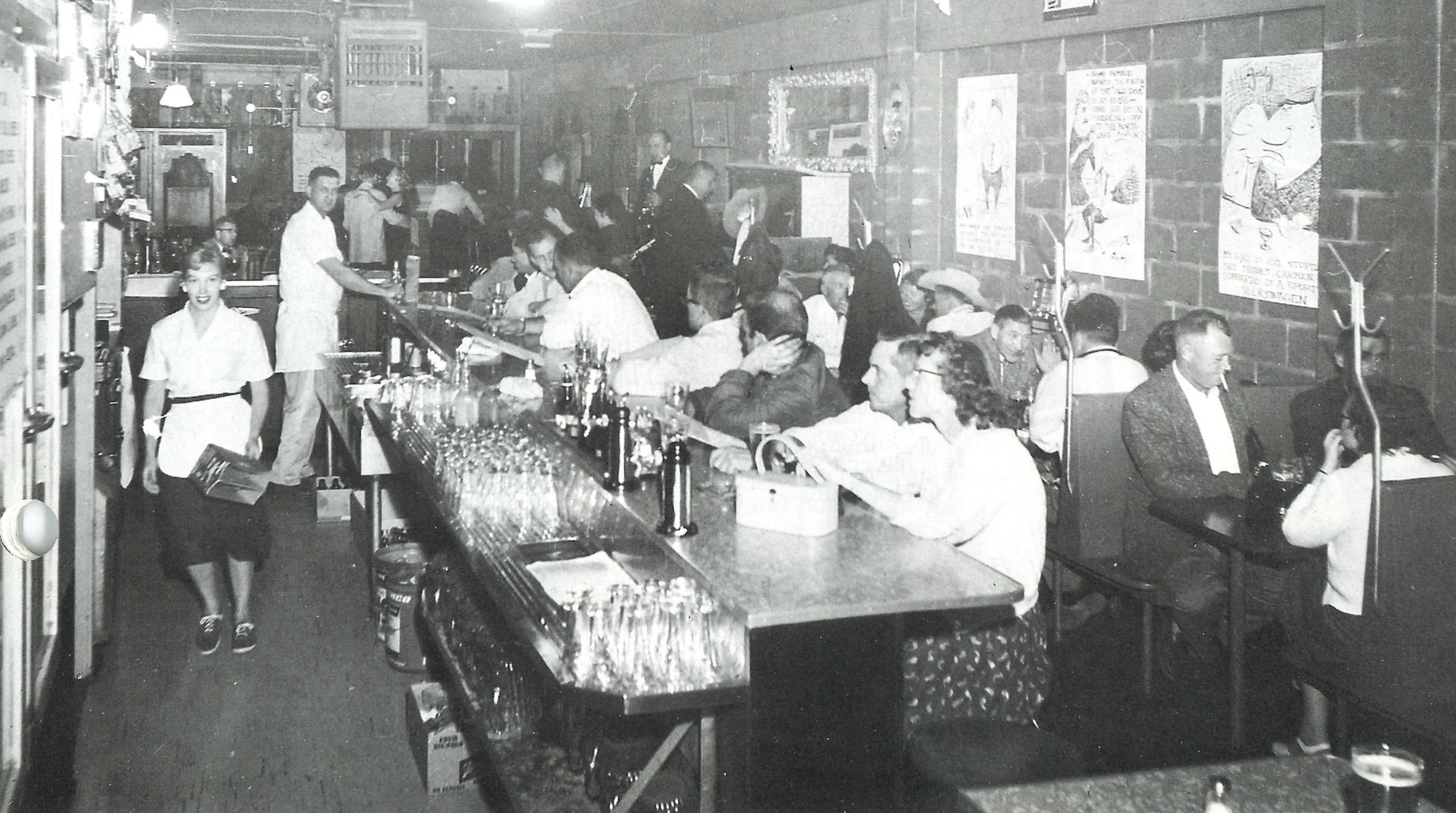

Some of the old haunts are ghosts now, but others are scaring up plenty of student business.
They’re the places we went to get away from it all. The places we went for pizza or a burger when we just couldn’t face another meal in the dorm or the HUB. The places where we went to have a cup of coffee with everybody else who didn’t have a 10 o’clock class; a change of scene when the paper we were writing just didn’t come together or the type in the textbook was beginning to blur; or a place to get a beer, especially in the years when Washington’s blue laws prohibited the sale of alcoholic beverages within a mile of the campus.
Sometimes they were the places we went to get into things. Depending on your era, that might have been the swing sounds of big band music or the pulsing beat of heavy metal. Places, perhaps, to lament a war or to celebrate a football victory. Some are long gone. The Hasty Tasty, for example, is now a vegetarian restaurant called Silence-Heart-Nest. The Century is the University Sportsbar and Grill and is owned by a WSU graduate. The Little Red Hen has moved to Green Lake.
Some are right where you left them. The Red Robin is bigger and slicker and has been more-or-less replicated at locations around the nation. The Blue Moon is almost unchanged and it’s still OK to carve your name in the tables. What follows are glimpses of eight of the most popular, historic or unusual spots.
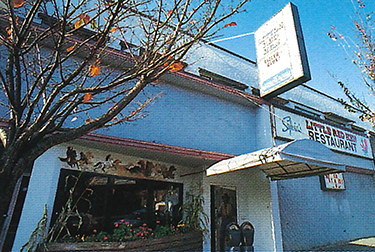
The Little Red Hen in 1991.
Red-and-white checked tablecloths, log walls and beamed ceilings contributed to the ambiance of the Little Red Hen, a favorite spot for chicken, pizza, onion rings and beer in the ’50s and ’60s. Judy Olsby, daughter of the original owner, recalls that the UW’s Bachelors’ Club (an organization that proclaimed itself dedicated to enhancing school spirit and characterized by white shirts and derby hats) spent Tuesday evenings at the Red Hen. “I think they had been thrown out of every tavern in town,” recalls Olsby, who still owns the restaurant now located near Green Lake. The original Little Red Hen, located at the corner of 50th and Phinney Ave., was torn down in 1967 to make way for an apartment building. A few artifacts from the old building adorn the new location at 7115 Woodlawn N.E., including a section of fuselage from the “Alice Blue Gown,” a World War II B-24 used in the movie “Twelve O’Clock High.”
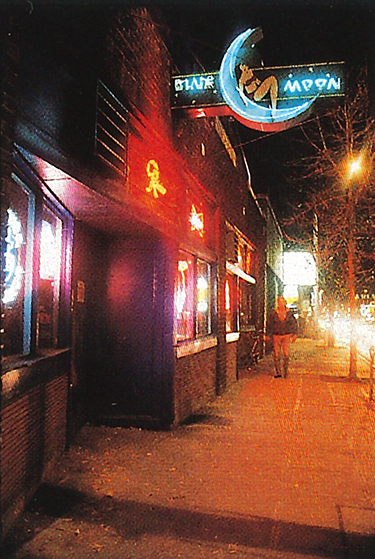
The iconic Blue Moon on 45th Street NE.
Spanning the decades from FDR to George Bush, the Blue Moon has seen, and heard, it all. “The politics are still left of center, to put it politely,” says Bob Morrison, ’71, who, in 1982, purchased the venerable tavern. Originally called the Big Dipper, the Blue Moon Tavern opened in 1934, the year prohibition was repealed in the state. Iconoclastic UW professors such as poet Theodore Roethke and architect Victor Steinbrueck found it a haven of free speech during the McCarthyism of the 1950s. Campus lore maintains that Roethke celebrated at the Blue Moon after winning the Pulitzer Prize in 1954. So widespread was its reputation as a center for Seattle’s counterculture, that Allen Ginsberg landed on the “Moon” when he was in town as did, according to legend, beatnik author Jack Kerouac.
Today’s Blue Moon retains its traditional “rough and tumble” ambiance, says Morrison. Patrons still carve their names into tables and booths. He repaints the rest rooms every three months or so when “the graffiti gets stale or there’s no place left to write.”
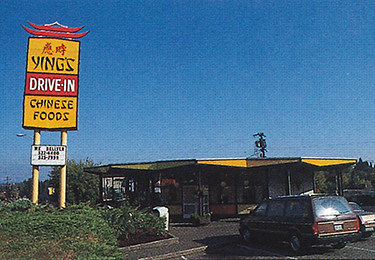
A Chinese restaurant took the place of the Coon Chicken Inn.
A national depression faded and World War II flared during the era when students flocked to the Coon Chicken Inn, with its popular basement “Cotton Club.” “It was a chicken dinner place and tavern,” says Norm Porteous, ’41, about the establishment located just beyond the city limits at Lake City Way and 20th Avenue N.E. “But I don’t think many students ate chicken.” Those few who did have an appetite could a obtain a complete, shrimp cocktail-to-dessert chicken dinner for $1 or a chicken sandwich and french fries for 25 cents. The Coon Chicken Inn has long passed into history, both as a restaurant and an example of the regrettable racial insensitivity that existed in the pre-civil rights era. A Chinese restaurant now occupies the site.
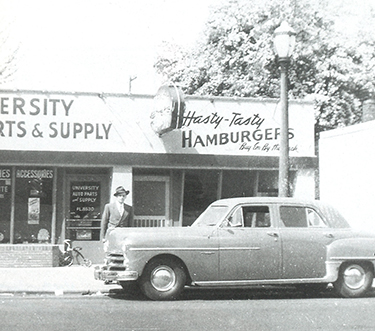
Hasty Tasty was a classic burger hangout.
One of the more enduring eateries—popular from the late-‘40s through the late-‘70s—was the Hasty Tasty on the “Ave” across the street from the Century Tavern. While the McCarthy witch hunts, the Korean War, and Vietnam student protests came and went, the Hasty Tasty just kept on feeding students 24 hours a day. “They delivered,” recalls Nancy Jones Nash, ’51. “That was the big deal. We’d call the Hasty Tasty at midnight.” The Hasty Tasty finally closed, and the familiar sign came clown, in 1979. It was succeeded by a restaurant called Avenue 52. In the mid-‘80s the site became a vegetarian restaurant, Silence-Heart-Nest.
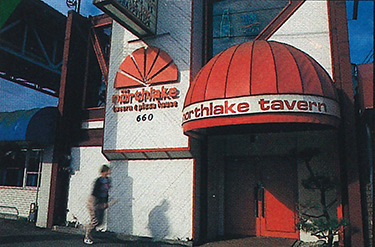
The Northlake Tavern in 1991. A shot if its interior from 1958 is at top.
Pizza and piano music, including a Gay ’90s review on weekends, were ’50s-era highlights at the Northlake Tavern. Students mingled with Bohemian types and artists who made the Northlake a second home. “The owners encouraged us to draw pictures when they found out we were art students,” recalls Gordon Anderson, ’54, ’58, who drew the posters shown in this 1957 photograph. Now remodeled and considerably gentrified, the walls are decorated with drawings by Seattle Post-Intelligencer cartoonist David Horsey, ’75.
The Watergate trials and the Bicentennial were still on everyone’s mind when, in 1976, the Lox Stock and Bagel opened on the “Ave” and swiftly achieved a popularity with students that continues today. Inexpensive beer and low-priced well drinks are among the attractions. So is its proximity to the Greek system, according to one ’88 grad. Thursday was the big night, he reflects, “wall to wall people.”

The Century has
become the University
Sportsbar and Grill.
Another magnet for Seattle’s ’60s and ’70s counterculture was the Century Tavern. “The history of this place is amazing,” says John Dolecki, a WSU graduate who currently owns the establishment. As Dolecki recalls, one of the group of radicals known as the “Seattle Seven” was arrested in the Century in the spring of 1970. (The seven were accused of inciting a riot at the Seattle Federal Courthouse during protests against the “Chicago Seven” conspiracy trial and the Vietnam War.) Since 1987, the popular bar has been called University Sportsbar and Grill.
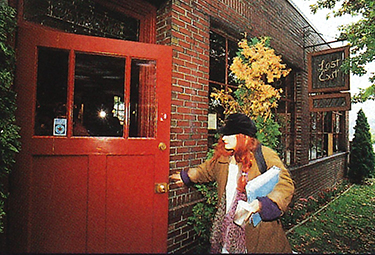
Last Exit on Brooklyn in 1991.
The year was 1967. It was the “Summer of Love” in San Francisco’s Haight-Ashbury district and 9,500 Americans died in Vietnam. Thurgood Marshall was sworn in as the first black justice of the United States Supreme Court, 150,000 anti-war demonstrators marched on the Pentagon and the Last Exit on Brooklyn, a coffee house, opened its doors at 3930 Brooklyn Avenue N.E. Definitely on the leading edge of today’s caffe latte trend, the Last Exit has sold espresso for about 15 years, says veteran employee Tom Hotchkins. A quarter century of operation has not diminished the easygoing atmosphere of the counterculture days. Folks peddling almost everything from T-shirts to fortune telling services are still welcome to circulate among the patrons. A tarot card reader (Hotchkins recalls that her name was Eve) has offered her insights off and on throughout the years, but not recently. “We haven’t seen Eve for a while,” reflects Hotchkins.
What began in 1943 as Sam’s Red Robin Tavern next to the University Bridge is now a franchise operation, based in Irvine, Calif., with restaurants in Alaska, New York, Florida, Arizona and up and down the West Coast. The chain specializes in hamburgers and “creative beverages” such as “Electric Watermelon Nuclear Iced Tea” and “Miami Ice.”
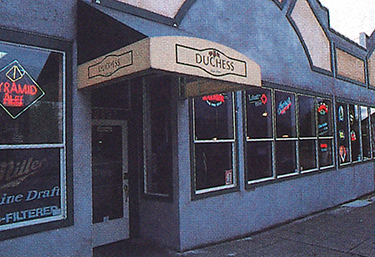
The exterior of the Duchess has been remodeled for the 1990s.
“The Duchess on Thursday nights. Oh, my goodness!,” recalls Lisa Trenholm Helber, ’79. The Duchess—along with the Red Robin, the Century and the Blue Moon—shared the distinction of serving the nearest “beer” to campus in the era when state law forbade the sale of alcohol near the University. Enforcers of the state liquor laws have occasionally found fault with the management of this long-popular student hangout, complaining, now and then, about such infractions as “permitting patrons to consume while standing” or allowing “boisterousness on the premises.” A far more serious infraction of the law occurred at the Duchess in 1984 when a patron was shot to death by his pool game opponent. Today’s more gentrified Duchess still packs them in. The menu is larger and the ambiance includes an open-air courtyard and putting green.